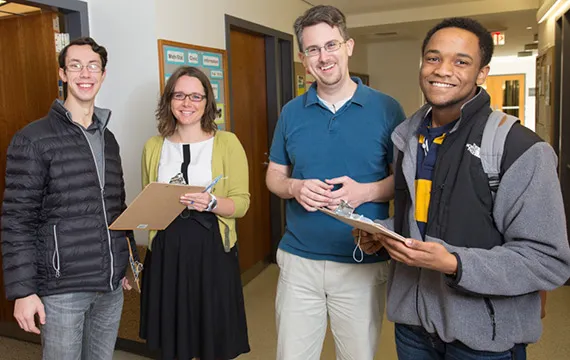Students Canvass Polling Stations on Election Day in Lang-Center Funded Statistics Project

On Election Day, 100 Swarthmore students learned firsthand how statistics can make a positive impact on the community.
Armed with clip boards, pencils, and surveys translated into nine different languages, students from the College's applied statistics classes hopped on SEPTA trains and traveled into Philadelphia to conduct surveys of exiting voters at 30 different polling stations scattered throughout the city.
The goal of the project was to survey voters in an attempt to better understand the voting experience across the city's polling stations.
"We have a diverse city, so one of the goals was to find out if some of the issues vary by demographic groups," says Assistant Professor of Statistics Kelly McConville, who helped orchestrate the project along with Scott Cook, visiting professor of mathematics and statistics.
In groups of three and four, the students – wearing garnet stickers that clearly identified them as Swarthmore College students, as opposed to lobbyists or campaign workers – surveyed every third person to exit their assigned polling station.
Surveys were completely anonymous and did not ask constituents who they voted for, but instead focused on identifying various issues with the voting processes in and out of the booth. Along with asking for demographical information, the survey asked constituents about voter identification requests and accessibility to the polling stations.
While not completely representative of the city (polling stations close to train stations were chosen to accommodate students' busy schedules), the data collected by the students will be analyzed in class and then compared to similar data from the Pew Research Center, in an attempt to see if the demographics of those voting match the known demographics of the areas sampled.
This was the first time either McConville and Cook had attempted this kind of large-scale community-based learning project, which they believe has encouraged the students to take more ownership over the project. Additionally, McConville believes the value of this kind of project comes in the real-life application of the coursework.
"I want the students to see the power of statistics and how it can be used to answer relevant societal questions," she says about the project, which was funded by the College's Lang Center for Civic and Social Responsibility. "In all of my statistics courses, I do my best to show my students how statistics is intertwined with their own interests and majors. I think a project like this where they go out and interact with society will help them see how true this really is."
Like many students who participated in the project, Sona Kumar '17 of Charlotte, N.C., was pleasantly surprised at the reaction she received from voters at the Church of St. Luke and Epiphany polling station. "I did not anticipate people's responses to the project – most people were more than willing to participate," she says. "I enjoyed listening to what they had to say about the polling process and just life in general."
Dylan Gerstal '17, a political science major from Ridgewood N.J., was also impressed with the willingness of voters to participate in the survey. "I expected many of the voters to ignore us," he says, "but the majority of them were very friendly and receptive to our survey."
For Gerstal and his group, the only hiccup came with the polling location itself – a hair salon.
"At first, our group was thrown off by the fact that we could not poll inside the polling station, because we did not have poll-watching licenses," he says. "Instead, we stood on the sidewalk outside of the hair salon, which took some time getting used to."
While most students reported positive experiences at the polls, logistical difficulties were anticipated and even welcomed by McConville.
"I wanted students to have the experience of going through the process of collecting data themselves so that they understand it is a difficult, often messy process with loads of logistical constraints," she says. "Even with careful planning, we will be confronted by issues that we didn't anticipate."
One thing is for certain – most students valued the opportunity to engage with the community through the project.
"Working with data can make you forget the actual experience that those data are expressing," says Natalie Giotta '15, a political science major from Gainesville, Va. "Taking part in civic engagement reminds us that the statistics we're working with connect with real experiences of people."



